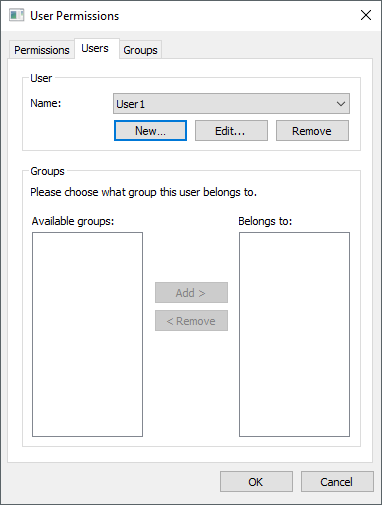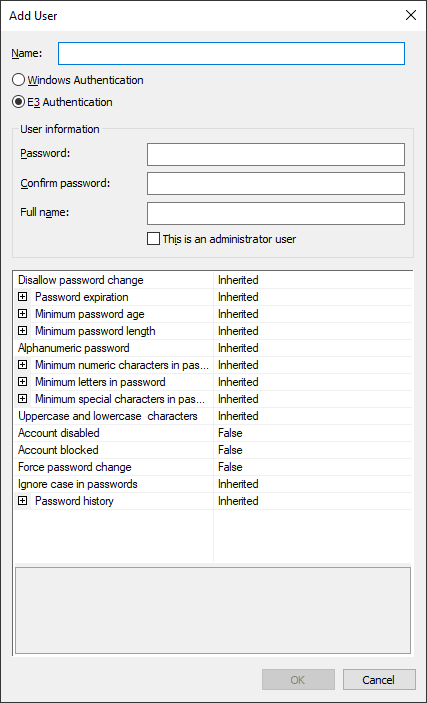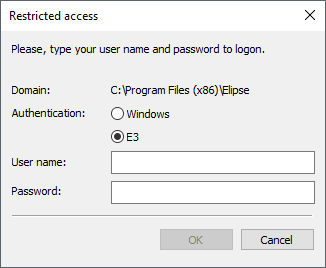The Users tab allows configuring information about users who have access or not to an application. To use this feature, click the File - Users menu and then select the Users tab.

Users tab
The available options on this tab are described on the next table.
Available options for the Users tab
Option |
Description |
|---|---|
Name |
Indicates the current user |
New |
Creates a new user |
Edit |
Edits properties of the selected user |
Remove |
Removes the selected user |
Available groups |
Shows all available user groups in an application |
Belongs to |
Shows all groups to which this user belongs |
Add |
Adds groups from the list Available groups to the list Belongs to |
Remove |
Removes groups from the list Belongs to |
When clicking New or Edit, the dialog box on the next figure is then displayed.

Add User window
The available options for this window are described on the next table.
NOTE |
The Inherited value in the available options of this window indicates that the value of that option is inherited from the group that user belongs to or from the system. |
Available options for Add user window
Option |
Description |
|---|---|
Name |
Specifies the name of this user |
Windows Authentication |
This option allows adding an existing user of a Windows network domain. This user's name must be formatted as DOMAIN\USER. When selecting this option, all other options on this window are disabled, except the This is an administrator user and This account is disabled option |
E3 Authentication |
This option creates this user in the current E3 Domain |
Password |
Specifies a password for this user. Please check the note later |
Confirm password |
Confirms the previously typed password. Please check the note later |
Full name |
Specifies the full name of this user |
Enables this user as an administrator |
|
Disallow password change |
Indicates that this user cannot change their password. This change can only be performed by an administrator |
Password expiration |
Indicates whether this user's password has an expiration time. Before this time is over, a dialog box is displayed indicating how many days are left for expiration and offering an option to change the password. After that period, the password expires and must be changed. If this option is enabled, configure in the Days to expire item a time for this password to expire |
Minimum password age |
Indicates whether there is a minimum time in days for this user's password be used before changed. The value of the Minimum age in days item must be between 1 (one) and 730. Defining this value as 0 (zero) allows this user to change their password immediately. NOTE: If the Password expiration option is configured, the value of this option cannot exceed the value configured in the Days to expire item |
Minimum password length |
Indicates whether a password must have a minimum size of characters. If this option is enabled, configure in the Minimum characters item a minimum value of characters for a password |
Alphanumeric password |
Indicates whether this user's password must contain letters and numbers |
Minimum numeric characters in password |
Indicates whether a password must have a minimum number of numeric characters. If this option is enabled, configure in the Minimum numeric characters item a minimum number of numeric characters for a password |
Minimum letters in password |
Indicates whether a password must have a minimum number of letters. If this option is enabled, configure in the Minimum letters item a minimum number of letters for a password |
Minimum special characters in password |
Indicates whether a password must have a minimum number of special characters. If this option is enabled, configure in the Minimum special characters item a minimum number of special characters for a password |
Uppercase and lowercase characters |
Indicates whether this user's password must contain uppercase and lowercase characters |
Account disabled |
Indicates whether this user's account is disabled |
Account blocked |
Indicates whether this user's account is blocked. This option is enabled automatically if the password expires or if this user types a wrong password several times |
Force password change |
Indicates that this user must change their password when executing the next login |
Ignore case in passwords |
Indicates that a password validation is performed by not differentiating uppercase and lowercase letters. Enabling this option is not recommended |
Password history |
Indicates whether the last passwords of this user are stored and cannot be used. If this option is enabled, configure in the Number of passwords item how many passwords must be stored. After reaching the value indicated in this item, the oldest password is discarded and can be used again |
In case of editing an existing user, changing the Password field implies in deleting the content of the Retype password field and vice versa, but only in the first time users edit any of these fields. |
When performing a user's login (by using Viewer's Login method or by using the File - Login menu), the dialog box on the next figure is then opened.

Login window
If the Windows authentication mode is selected, the User name and Password fields are disabled and filled in with the name and password of the currently user logged in the network domain. To select another user belonging to a network domain, click Other user. If the E3 authentication mode is selected, fill in information about a user and a password for an E3 Domain's user in the User name and Password fields, respectively.
When the This user is an administrator option is enabled for a given user, this user can, at run time, change all configurations displayed on the Users tab.
These privileges can be configured via scripts using Viewer's UserAdministration method, which enables a user's dialog box at run time.
NOTE |
Only an administrator has access to Viewer's UserAdministration method. |
When clicking Remove, an application shows a message box asking to confirm whether users want to remove that user or not.
Users can also belong to a group, thus sharing the same configurations with other users of that group. To do so, the Available groups list contains all groups available in an application that may contain the selected user, and the Belongs to list contains a list of groups to which the selected user already belongs. To add a user to a group, follow these procedures:
1.Select a user to add to a specific group.
2.On the Available groups list, select a group to which this user must belong.
3.Click Add to add that group, which then appears on the Belongs to list.
4.To remove a group, select it from the Belongs to list and then click Remove.